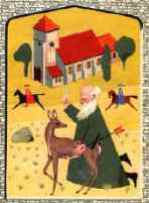

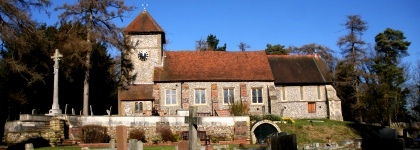
JULIA'S SABBATICAL
As many people know, I spent several months some years ago on a sabbatical from the choir. I visited a different church every Sunday. How did I choose? British Rail helped! With the rebuilding of London Bridge station, a different London terminus was open each weekend so I picked a church near the open station. I had a good list of churches to choose from suggested by a friend. I was very open minded and did not pick a particular style of worship, although on several occasions I wanted to hear a particular preacher. I was encouraged by the numbers attending the services particularly the number of men. I was also surprised by the frequent use of the hymn book in use at St. Giles - English Hymnal Revised.
What follows is my 'trip advisor' view of the wonderful variety of services I attended. Follow the links to explore the websites of the places of worship visited.
St. James's Church, Piccadilly had a very varied congregation (including 5 dogs). They had the best and very clear service sheet. An excellent sermon was preached by the Revd. Lucy Winkett.
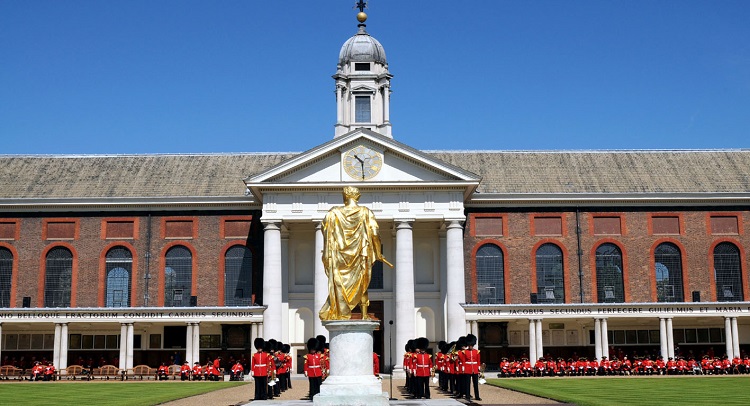 |
The
Royal Hospital, Chelsea (left) had a wonderful opening to the service with the choir
singing the Introit from the marble entrance hall. I visited on Mothering Sunday and so I received a large bunch of daffodils tied firmly with green garden string. The Chapel Royal of St. Peter ad Vincula at the Tower of London. Initially, I had to queue by a certain drawbridge and at the appointed time a Beefeater escorted us into the very historic chapel. Their excellent professional choir sang a beautiful Epiphany carol service. |
On two occasions I unexpectedly met St. Giles contacts. At Evensong in Westminster Abbey I came across the Byrne family. Duncan Byrne, who used to sing in our choir, is now headmaster of Loughborough School and he had two sons in the choir of Westminster Abbey.
St. George's Hanover Square had a licensing service for a new priest and there I met Erica Olley (Phillips) another previous member of St. Giles choir. Refreshment at the end of the service was a glass of champagne, as until recently a wine merchant had used the crypt for storage and this was part of their rent.
The Chapel Royal, St. James's Palace To reach this chapel you have to pass armed guards as the chapel is part of the palace. The seats were covered with thick purple velvet but I was careful not to occupy seats marked 'Royal Household'. The boys in the choir here are 'Children of the Chapel's Royal' and wear the Tudor uniform. There was no member of the Royal family in their special gallery seats for my visit!
My next visit was to The Royal Military Chapel (The Guards' Chapel). The music for the choral Holy Communion was accompanied by the Band of the Royal Yeomanry. Alongside each seat was a brass holder in which to rest your sword.
|
The Temple Church had a very accomplished choir of boys and the singing was delightful. The communion setting used was Britten's 'Missa Brevis'. The church is laid out in collegiate style and there was a rather complicated route to the altar to receive communion in order to avoid passing between the choir stalls. There was a very large congregation. |
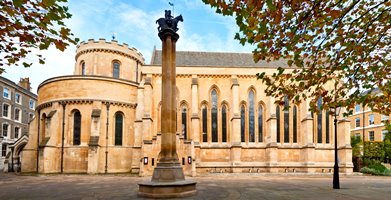 |
I attended a service at The Chapel Royal of Hampton Court Palace on a very gloomy February day. I had to enter the palace by a special side gate but once inside the chapel, it felt very intimate and atmospheric. The Tudor vaulted ceiling there was installed by Henry VIII. The boys of the choir were again part of the 'Children of the Chapel's Royal' and had the historic red uniform.
The most inspiring and unusual music for a service was at the Chapel of St. Peter and St. Paul, at the Old Royal Naval College in Greenwich. The choir is composed of 20 students from Trinity College of Music (which is based in Greenwich) and is of a very high standard. The Introit was by John Dankworth and the setting of the mass was 'The Little Jazz Mass' by Bob Chilcott all accompanied by piano, electric guitar and drums. Their service always ends with one verse of 'Eternal Father strong to save'.
For Palm Sunday, I was determined to find a donkey! St. Martin-in-the-Fields came up trumps! Those wishing to process were asked to meet at Admiralty Arch and led by the Chalk Farm Salvation Army Band, the choir with long palms and the donkey with large panniers full of palm crosses, we set off with a police escort as roads needed to be crossed. The procession stopped several times whilst crossing Trafalgar Square in order to sing a hymn, say a short prayer and distribute palm crosses. The donkey then led the way up the steps from Trafalgar Square and the people made their way into the church for a wonderful dramatic reconstruction of the Passion Narrative. The donkey meanwhile made its way to St.James', Piccadilly!
 |
The Queen's
Chapel of the Savoy (left) is hidden away behind the hotel - a beautiful and very
historic little chapel whose excellent choir is from St. Olaves
School in Orpington. Southwark Cathedral was the most family friendly place of worship I visited. A well attended Sunday School - about 40 children in different age groups - joined the service for the communion. St. Brides in Fleet Street has an excellent professional choir of adults in rust coloured academic robes. The Choral Eucharist was to a setting by Rubbra. |
Holy Trinity, Brompton (HTB) was fascinating. I was joined by a friend and we were asked to be seated 20 minutes before the service in order to get a seat. Everything was done to a very high standard including the music group, the sound system, the lighting and the overhead screens. The service was broadcast to another site in London as so many people wish to attend. The preacher was Nicky Gumbel. There was a huge Sunday School in an adjoining building and in the crypt there was a cafe, library, bookshop, reading room and loos.
|
The Priory Church of St. Bartholomew The Great, West Smithfield, in the City of London, is a fascinating and very old church. I attended a Solemn Eucharist and Procession service. The choir stalls are at the west end of the church and the congregation processed around the church following the choir whilst singing a very long hymn. Many people recognise this building as it featured in the film 'Four Weddings and a Funeral'. A party of three from St.Giles went to Canterbury Cathedral (right) on Easter Day for the Sung Eucharist and to hear the Archbishop of Canterbury deliver his Easter message, which was very stirring. An Easter greeting and a handshake from the Archbishop at the end was very special! |
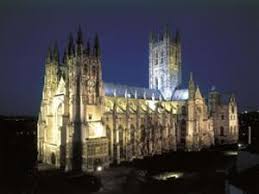 |
This was a fascinating project and it was good for me to experience so many different styles of worship. All the churches were well attended although the television producer who showed an interest has not come back to me.
My Sabbatical Continues...
Thank you to all those who responded so positively to the account of my sabbatical last year.
 |
One person who got to hear about it was the
Rochester Diocesian secretary of the Prayer Book Society. She invited
me to join the regular worshippers at the private chapel at Knole
House. We were asked to assemble in the stable yard. The chapel is at
the heart of the private apartments still retained by the
Sackville-West family and therefore not open to the public. As we
entered we walked past children's bicycles and family coats hanging up
in the hallway. The service, one of ten held each year was conducted by the chaplain, the Revd. Sophie Sutherland. It was a prayer book communion service. As Knole had been home to Thomas Cranmer whilst owned by the See of Canterbury from 1486 until 1538, the service had obvious attractions to the members of the Prayer Book Society. |
One of the curiosities of the chapel is its small Jacobean organ powered by a man standing alongside pumping the handle hard! With a suggested date of around 1620, it is possibly the oldest playable organ in England, with wooden keys and four ranks of oak pipes all within a rectangular panelled chest. We were able to thank Lord Sackville as we left the chapel.
Julia Hoadley, March 2019